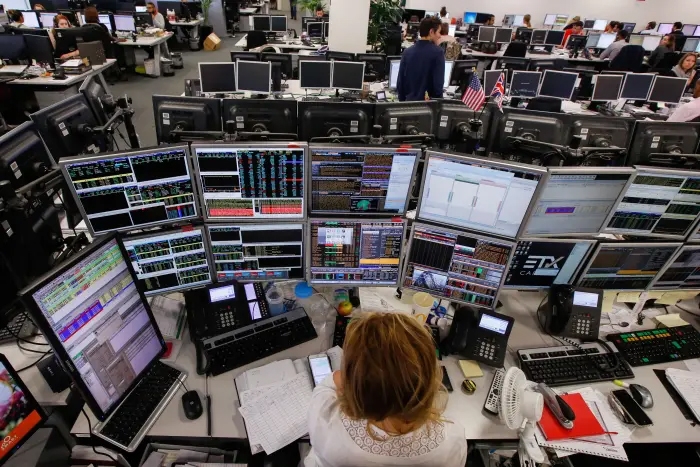
We’ve back to a risk-positive tone, with higher global equity markets overnight. Currency movements haven’t been particularly significant, although CHF and EUR are notably weaker.
Despite the seemingly endless number of commentators who argue that equities are way over-priced during one of modern economy’s deepest recessions, it’s a sea of green across the equity board. Investors seem buoyed by the easing of restrictions around the world, including Hong Kong, California and much of Europe – opening up economies and setting the scene for a recovery in activity.
The S&P500 is currently up 1.8%, with all sectors contributing. Europe’s Euro Stoxx 600 index closed up 2.2%. Supporting a more positive tone, oil prices are showing a nice recovery, with WTI prices up for the fifth day running, the longest streak in nine months. Brent crude is up through USD31 per barrel while WTI is over USD24. While excess supply conditions remain, the gap between supply and demand looks to be closing. An easing of lock restrictions is seeing increased demand, while shale oil production is being scaled back in the US alongside the significant cut in OPEC+ production.
The US ISM non-manufacturing report showed the very weak underbelly expected, with business activity, new orders and employment in the range of 20-30 and the headline index flattered by a spike up in supplier delivery times (usually a sign of economic strength, but in the current cycle inflated by the lockdowns).
Germany’s constitutional court outlined some red flags with regards to the ECB’s existing asset purchase programmes and directed that the ECB could continue but needed to carry out a “proportionality assessment” within the next three months. This will need to show that the ECB is buying government bonds consistent with the “capital key” (reflecting each country’s share in population and GDP) and isn’t straying into monetary financing of governments. The ruling sets the scene for a legal challenge against the ECB’s new €750b pandemic emergency purchase programme, which has even looser limits than previous asset purchase programmes. It doesn’t change the fact that euro area governments need to show some unity and step up with a fiscal recovery plan to support the economy, taking the pressure off ECB policy.
After digesting the ruling, the EUR fell and is now down 0.5% for the day at 1.0850. The ruling will mean less scope for the ECB to support peripheral bond markets. Italy’s 10 year rate rose by 10bps to 1.86% against a 2bps fall in the Germany 10-year rate to minus 0.58%. The US 10-year Treasury yield rose to a two-week high of 0.68%, but has since eased back down to 0.65%.
Apart from a 0.7% fall in CHF, other currency movements have been modest overnight. The NZD has seen some resistance near 0.6075, where it currently trades, up 0.2% from the NZ close.
The GDT dairy auction price index fell by 0.8%, a better outcome than we had expected. This was the sixth fall across the last seven auctions. Prices have fallen about 16% since late last year and we see further downside pressure as more EU and US demand comes on board against a backdrop of softer demand. Futures for the FY21 milk price have been heading south this year and recently fell below the $6 mark, suggesting dairy farmers’ incomes will likely be much lower than the current season’s estimate around $7.20.
QV house price data released this morning showed a 7.1% y/y gain in prices in the three months ending April, much of which pre-dated the lockdown.
The AUD isn’t much changed overnight either, sitting at 0.6455 this morning after a brief look up at 0.6475. The RBA’s update yesterday passed without much reaction. The RBA held the cash rate and 3-year yield target at 0.25%. The only change was the RBA broadening its repo-acceptable collateral to include investment grade corporate bonds to assist with the smooth functioning of markets. Weekly payrolls data showed that 7.5% of Australian jobs have been lost in the five weeks since the lockdown began, equivalent to about 1 million people losing employment since mid-March. Welfare data suggest that the unemployment rate could rise to 9-11% in April, on NAB estimates.
In the day ahead, NZ labour market data are released but, being for the March quarter, they will only capture the very early impact of COVID-19 so they don’t hold much interest. Tonight sees the release of ADP private payrolls data in the US, where the consensus expects to see a fall of a mind-boggling 21m.
Daily exchange rates
Select chart tabs
1 Comments
Equities are rising on hope, maybe
But mostly because Fed is offering $7 trillion in back stopping of bad debts and shitty corporate holdings.
So, that money is being swapped to Japan and ECB also.
So, earning potential for next 6-9 months on exchanges across world are obviously going to be 30% lower minimum but stocks are only 15-18% off highs. PE multiples are a joke. About 6% of USA pop owns shares.
25% of USA workforce is out of work. Total disconnect and divided world.

We welcome your comments below. If you are not already registered, please register to comment
Remember we welcome robust, respectful and insightful debate. We don't welcome abusive or defamatory comments and will de-register those repeatedly making such comments. Our current comment policy is here.